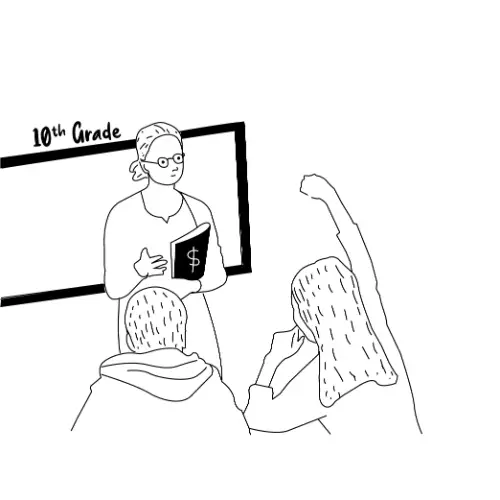The 10th-grade year is a vital stepping stone in money education, as students take what they learn from previous years and start applying it to more complex economic studies. These kids are only a few years from getting out of high school, moving into college or the workforce, and living independently. The money knowledge they gain now will affect the crucial decisions they make in the future. The core concepts they study in 10th-grade – the foundations of economics, microeconomics, macroeconomics, global economics, and personal finance – will shape their financial success. While it is a lot to cover, we at Kids’ Money have your back – head over to our 10th grade money lesson plans page for all the downloadable plans you need for your 10th-grade curriculum!
As you set the course for your students this year, make sure they receive supplemental support through money activities and games. When kids discover and review essential information through games, they learn. Let’s see the best options for online and hands-on activities you can use to boost your 10th-grade money curriculum!
Online Games
Online games and interactive sites that show kids how their finances will work in real-life situations are essential to money education. Many of the concepts your 10th-graders are learning are theoretical and can be challenging to grasp, so playing games that demonstrate these ideas is very helpful. Check out these practical and exciting activities.
Con ‘Em if You Can
This game lets your 10th-grade students take on the role of a scammer, allowing them to play the bad guy and use shady persuasive techniques to con others out of their wealth. The point of the activity is for students to see and learn the many ways fraudsters can try to trick people out of their money. Hopefully, when kids are older, they will recognize some of these techniques and avoid being scammed.
The Stock Market Game
This timeless simulation game shows kids the power of long-term investing, how volatile stocks can boost your account value but also send it crashing, and the various portfolios they can build for different risk tolerances. Teachers can adapt the game to any grade level, making this activity ideal for reviewing key market factors students learn at this age. You can assign this as a supplementary independent exercise or an ongoing center activity for teams to work on together.
The Payoff
Today, 10th-graders know all about social media, vlogging, and factors that affect online popularity, so this game is ideal for this age group. Your students get to control the actions of two up-and-coming vloggers as they compete to win a big-time contest, particularly the financial decisions they face. Students will see how to determine if money choices are smart or not within a tight window, putting (fun) pressure on them to show their knowledge quickly.
Financial Football
Teachers may see several of these games, including this engaging and interactive one, overlap different grades in high school, and for a good reason. This activity draws in sports fans and competitive students, making them make vital financial moves in a football game environment. With a powerful partnership between Visa and the NFL, this game delivers high-quality graphics and gameplay with sound economic principles.
Spent
Many of the money games 10th-graders play assume a certain level of financial success in their future; they will have a steady, decent-paying job with a roof over their heads. However, this game takes a much blunter look at reality and has kids imagine they are struggling to make ends meet: decisions revolve around which “needs” to cut back on instead of which “wants” they can prioritize. This activity builds empathy among your students, showing them that it is pretty common to live with limited means and demonstrate the tough decisions people make around the country every day.
Payback
College is expensive, and the types of financial aid available can be daunting, affecting kids’ financial success down the road. This interactive game lets students see the dangers of predatory lending and avoid falling into the student loan trap that can be challenging to crawl out of by simulating the risks in a safe environment. Your 10th-graders will appreciate seeing these situations while they still have a few years before college.
Shady Sam
It is a sad fact of life that not all lenders are out for their customers’ best interests. This game flips the script on video games and allows students to be the villain: in this case, Shady Sam, the loan shark, is out to make as much profit as possible off unsuspecting customers. Your students will have fun playing this game and learn about how lenders can reel uninformed customers into their high-interest loans.
STAX
This game is a group or individual activity that simulates twenty years of stock market performance in minutes, giving kids a realistic idea of how the market performs in various conditions. The stock market is driven by fear and greed, and your students will feel these different emotions pulling them and influencing their decisions as the market rushes upward and crashes down. Teachers can set up competitions between students or assign this exercise for independent work against the computer.
Plan Your Dream Prom
Many of your 10th-grade students will likely go to formals or prom in the next few years, and this site lets them see the costs of the event. Students can input different variables, like what they want to wear and how to get to the venues, and see if they can do it within their budget. This exercise is excellent for showing kids budgeting skills, how decisions impact their cash, and how to maximize their spending to have fun but not go into debt at the same time.
Charge!
This interactive game shows kids how credit cards work, the impact of interest rates on their purchases, and the actual costs of various products. Students click through a shopping site and select products they want to buy, learning that advertising techniques mislead consumers into thinking that items are a specific price but can cost much more with credit cards.
In-Person Activities
Your 10th-graders learn differently: some may thrive in gameplay, while others prefer hands-on worksheets and exercises. These activities are an excellent way to meet the needs of all learners, providing practical information and letting kids experience financial situations they will face soon.
Making Decisions
Much of financial success (or financial obstacles) comes down to self-reflection and why we make our choices. This worksheet breaks down the process, has kids analyze purchasing decisions and why they want to save for specific items, and requires them to come up with multiple solutions to a problem.
Should You Use Credit?
This activity demonstrates the advantages and drawbacks of credit to show kids that it can be a powerful, valuable tool or cause financial ruin. By going through actual situations where credit is a good idea and where it’s not, students will see the importance of managing their credit intelligently and using it cautiously.
Cars and Loans
Your 10th-graders are nearing or at legal driving age, and they likely plan to purchase a car soon after high school. This thorough activity walks them through the various costs and fees they will encounter in the car-buying process, including loan rates, terms, and leasing vs. buying. Students can complete research independently or in pairs to see if car buying is a reality for them right now.
The Influence of Advertising
Advertising is full of persuasive techniques, and kids can benefit by knowing which tactics companies use to draw them in and buy their products. The more knowledge your 10th-graders have about persuasive techniques and their money, the better! This exercise requires students to analyze a broad selection of print, video, and online ads to understand how advertising works.
Consumer Awareness
This worksheet reviews the concept of consumer awareness, helping kids see the whole picture before they buy a product. They analyze warranties, look at refund policies, perform comparative shopping, and determine how decisions are influenced, which should greatly help their financial futures. By being aware of the many factors involved in buying products, kids will be ready to handle significant purchases.
Saving and Investing
Two core concepts that 10th-graders explore in depth this year are saving and investing, which can make all the difference in the long term. This activity has students set short-term and long-term goals, set target dates to save specific amounts of money, and calculate money math problems that they will use after graduation.
Consumer Privacy
Understanding consumer privacy is essential for students, who need to know their consumer rights. Students should learn as much as possible to protect themselves from fraud and identity theft and know how to handle any situation where their identity is compromised. This worksheet has information that clarifies what public and private data is, walks students through accessing credit reports, and shows how companies use the information to target consumers with advertising and more.


